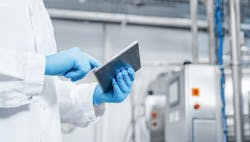As an auditor working in pharma, I take pride in knowing that what we do helps ensure the products people rely on to improve their quality of life and help them in times of critical need are safe, reliable and of the highest possible quality.
But in 2020, during a moment when people craved dependability more than ever, a wrench was thrown into our process: We could no longer conduct on-site audits of our suppliers and other partners — this included drug manufacturing sites and contract laboratories.
If you think this would present a challenge, you’re right. We’ve long been used to physically inspecting a site, talking to its employees in person, and reviewing original documentation. While remote audits changed all that, the profession has quickly adapted: One recent study out of Germany, for instance, showed no difference in the efficiency and effectiveness of remote internal audits when compared to traditional ones.
Now that the shift has been made, it’s unlikely that companies will pay for auditors like me to travel the world. But just because this is the new normal doesn’t mean that nothing’s changed. There are distinctive strategies necessary for doing remote audits successfully. Here’s what we’ve learned about doing them right in the past year.
More preparation required
Auditors always have a plan — but we’ve found that executing on all of it remotely can be a real challenge.
One way to navigate this issue is to really understand the risk areas before starting the audit, so you can focus your attention where it’s most needed. For instance, if you’re going into a contract testing lab, risk areas might include any errors made by testing in the last year, learning gaps and process breakdowns.
Doing that prep might entail asking more questions of the company in advance, requesting additional documentation and data, assessing the site map of the physical facility to identify areas you need to examine more closely, and knowing which questions you want to ask (and to whom) on the day itself.
Don’t let lines of communication falter
In a traditional audit, you’re sitting in a room reading documentation while someone watches. The shift to remote audits means the auditor can no longer simply look up and ask that person a question. During a walk-through of a site, you might also stop and chat with various team members to get a feel for the place. Working remotely, you’ve got to set up more discrete interviews with specific employees. Along the way, similar communication challenges crop up within the audit team themselves, who may also be at different remote locations.
Keeping lines of communication open and building relationships is key. On the one hand, that may involve using different technologies, be it live video feed for virtual tours or collaborative workflow technologies (e.g., Microsoft Teams); on the other, it simply underscores the importance of ensuring everyone knows the objectives and potential impact of the audit throughout the process.
Securely sharing documentation
The shift to remote audits — when documentation must be shared online — has, surprisingly, forced us to trust each other more. With that said, it helps to use methods and technologies that offer security, whether it’s signing non-disclosure and confidentiality agreements or giving password-access to an online document repository for 24 hours.
Despite all the new technologies, it’s also crucial to remember that successful audits — remote or not — are built on mutual respect, trust and connection.
It’s tempting to look at the ways audits have changed and think these human interactions will go by the wayside. But if there’s one thing I’ve learned in the remote world, it’s that audits are here to stay and none of us can escape. But be assured human interaction is still more important than ever.





